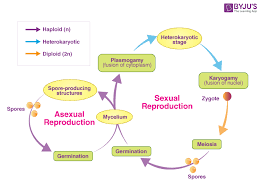In the previous articles, a detailed exploration of the morphology of fungi was presented. This article will focus on the reproduction and alternation of generations in Phytophthora and Rhizopus.
Types of Life Cycles and Alternation of Generations
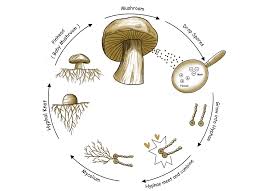
1. Life Cycles and Alternation of Generations in Phytophthora
This fungus belongs to the Division Oomycota. There are about 75 species in this genus, most of which are parasites on flowering plants. The species Phytophthora infestans is of great economic importance as it causes a severe potato disease known as potato blight or late blight of potato.
Morphology of Phytophthora
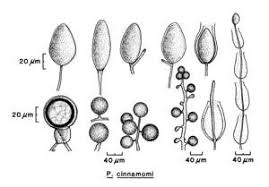
The mycelium of Phytophthora is profusely branched and consists of aseptate, hyaline, and coenocytic hyphae. These hyphae ramify through the intercellular spaces of host tissues. The mycelium produces haustoria, which penetrate the host cell walls and enter the cells to absorb nourishment. The haustoria may be simple or branched. Phytophthora reproduces both asexually and sexually.
Asexual Reproduction in Phytophthora
In warm and humid conditions, asexual reproduction is the norm. During this stage, a tuft of slender, branched hyphae typically arises from the internal mycelium. These hyphae emerge through the stomata or pierce the epidermal cells on the lower surface of the leaf.
In tubers, they emerge through injured portions of the skin. These aerial hyphae are hyaline and branched, bearing a sporangium at their tip. The hyphae that bear sporangia or conidia are known as sporangiophores or conidiophores, respectively. The sporangia are thin-walled, hyaline, and lemon-shaped with a beak-like projection or papilla at their tips.
The mature sporangia easily detach from the sporangiophore, which is branched and displays nodular swellings at the points where the sporangia detach. Wind, rain, or contact with neighboring leaves disperses the ripe sporangia onto adjacent potato plants or into the soil. If the sporangia do not germinate within a few hours, they lose viability.
When the sporangia fall on the leaf of a host plant, they germinate, depending on the moisture and temperature. In the presence of water and temperatures below 12°C, the sporangium acts as a zoosporangium, dividing its protoplast into 5-8 uninucleate daughter protoplasts, which transform into zoospores.
The zoospores are uniform and biflagellate, with one flagellum of the whiplash type and the other of the tinsel type. The zoospores are released into a vesicle, which soon bursts, liberating the zoospores. These zoospores swim briefly before settling on a substrate, where they lose their flagella and germinate.
During germination, the zoospore produces a short hypha called an appressorium. The appressoria help to anchor the fungus on the surface of the host leaf. A narrow, peg-like infection hypha develops from the appressorium and penetrates the host leaf.
At temperatures up to 24°C and low relative humidity, the sporangium germinates directly, behaving like a conidium. It produces a germ tube or short hypha, which penetrates the host leaf. Sporangia washed into the soil germinate and infect the tubers, causing them to rot by harvest time or during storage.
Under favorable conditions, several asexual generations can occur in one growing season, leading to rapid propagation of the fungus and the spread of the disease.
Read Also: How to Extract and Package Snail Slime (Snail filtrate) for Commercial Use
Sexual Reproduction in Phytophthora
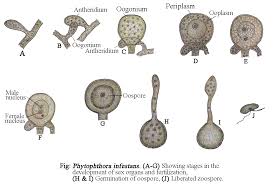
Sexual reproduction in Phytophthora is oogamous, involving antheridia (male sex organs) and oogonia (female sex organs). These structures arise at the tips of short lateral branches as antheridial and oogonial initials, respectively. Phytophthora infestans is heterothallic, meaning two genetically distinct types are required for sexual reproduction.
The antheridium is a club-shaped structure with one or two nuclei, which later divide to produce about 12 nuclei. During fertilization, only one functional nucleus remains, while the others degenerate. The oogonium, developing on a neighboring hypha of the antheridial branch, grows across the antheridium and swells into a pear-shaped or spherical structure.
It contains dense cytoplasm and many nuclei (about 40). The protoplast of the oogonium differentiates into an outer multinucleate periplasm and a central uninucleate ooplasm. The central nucleus divides into two, with one disappearing and the other functioning as the egg nucleus. The nuclei in the periplasm eventually degenerate.
The oogonial wall forms a receptive spot, where it disintegrates, allowing the antheridium to push a short fertilization tube into the oogonium. The fertilization tube penetrates the periplasm and reaches the ooplasm, delivering the male nucleus and surrounding cytoplasm.
The male and female nuclei fuse, resulting in fertilization. The fertilized egg forms a thick wall around itself, becoming an oospore. When conditions become favorable, the oospore germinates, likely undergoing meiosis during germination.
The oospore either develops directly into a mycelium or forms a terminal sporangium, which produces zoospores that grow into new mycelia after being liberated.
In the life cycle of Phytophthora, an asexual cycle occurs repeatedly under favorable conditions, while the sexual cycle takes place before unfavorable conditions, forming a resting spore. These cycles typically alternate.
2. Life Cycles and Alternation of Generations in Rhizopus
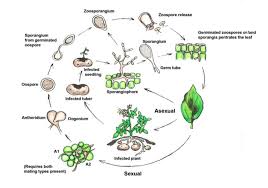
Rhizopus, a member of Division Zygomycota, is commonly referred to as bread mold, frequently found growing on stale bread. It is a saprophytic fungus that also thrives on decaying fruits, vegetables, and other food materials.
Rhizopus stolonifer sometimes acts as a facultative parasite on strawberries, causing a transient disease called ‘leak’ and ‘soft rot’ disease in sweet potatoes, yam, and cassava tubers.
The mycelium forms a white, cotton-like, fluffy mass composed of numerous slender, branched hyphae. Three types of hyphae are present: (i) rhizoidal, (ii) stolons, and (iii) sporangiophores. Rhizoidal hyphae are brown, slender, and branched, arising from the lower surface of the stolon at specific nodal points, aiding in anchorage and the absorption of water and nutrients from the substrate.
Stolons, which grow horizontally over the substrate, are larger and slightly arched, filling the surface of the substrate as they grow in all directions. Sporangiophores, the third type of hyphae, develop during the reproductive phase, arising from the nodal regions opposite the rhizoidal hyphae, and grow vertically, bearing sporangia at their tips.
Asexual Reproduction in Rhizopus
Rhizopus reproduces asexually by producing multinucleate, non-motile spores within small, round, black sporangia. These sporangia form terminally and singly on unbranched sporangiophores.
A mature sporangium has two distinct regions: a central, less dense, vacuolated region with fewer nuclei called the columella, and a peripheral dense region containing many nuclei called the sporoferous region. The protoplast of the columella remains continuous with that of the sporangiophore.
The sporoferous region undergoes cleavage, forming multinucleate segments that round off, secrete walls, and become sporangiospores. These unicellular, multinucleate, non-motile aplanospores are globose or oval in shape.
Upon maturation, the sporangium bursts, releasing the spore mass, with part of the wall remaining as a collar-like fringe at the base. The spores are dispersed by wind, and when they land on a suitable substrate under favorable conditions, they germinate into a short germ tube that branches profusely, producing the three types of hyphae.
During unfavorable conditions, Rhizopus produces thick-walled chlamydospores, which store reserve food. These spores form intercalarily, allowing the organism to survive harsh conditions during which the mycelium perishes. When favorable conditions return, the chlamydospores germinate and produce normal mycelium.
Read Also: Snail Farming Step-by-Step Beginners Guide
Sexual Reproduction in Rhizopus
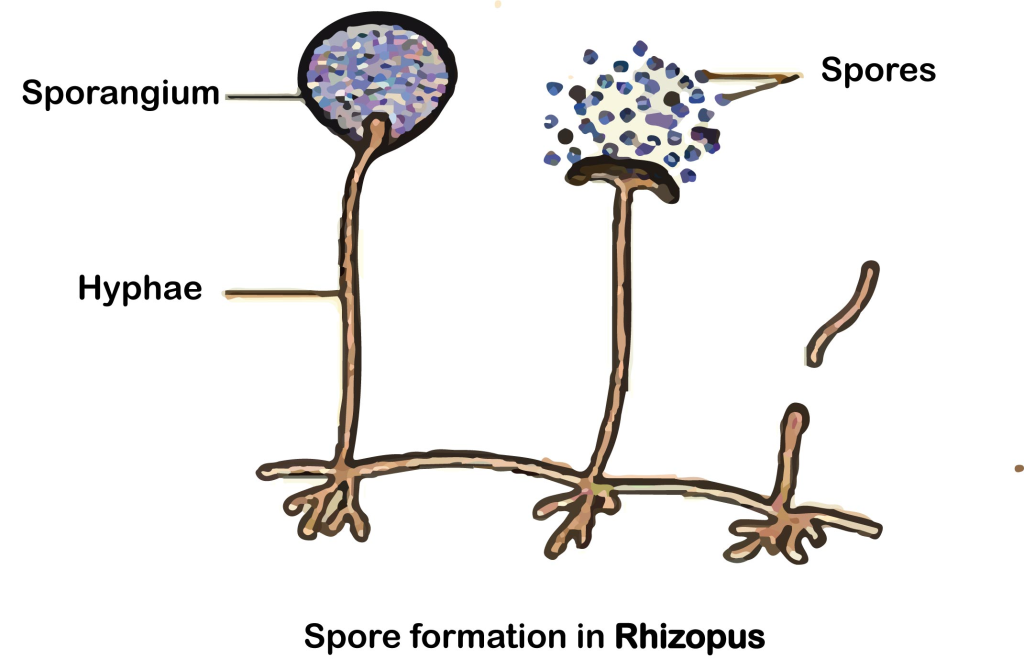
At the end of the growing season, Rhizopus undergoes sexual reproduction by conjugation. The fusion of gametangia, a process called gametangial copulation, occurs. Rhizopus species may be homothallic or heterothallic. In heterothallic species, the mycelia belong to two mating types or strains, one plus and the other minus.
During sexual reproduction, hyphae from both mating types (+ and -), called zygophores, are attracted to each other, producing progametangia that meet at their tips. These tips enlarge due to the accumulation of cytoplasm and nuclei and are separated from the basal portion by cross walls, forming the terminal portion called the suspensor.
The entire gametangium transforms into an aplanogamete, and upon maturation, the walls between the two gametangia dissolve, allowing the gametes and their nuclei to fuse, resulting in a zygospor. The zygospore grows, secreting a thick, two-layered wall around it, with the outer layer called the extine and the inner layer called the intine.
Before germination, the diploid nuclei within the zygospore undergo meiosis, producing numerous haploid nuclei. During germination, the zygospore absorbs water, causing the extine to rupture.
The intine grows outward as a germ tube or promycelium, which is of limited growth and produces a terminal sporangium called the zygosporangium or germ sporangium. Inside, numerous non-motile germ spores (meiospores) form and, upon release, develop into new mycelia.
The life cycle of Rhizopus consists of two phases: asexual and sexual. The asexual phase includes the mycelium, sporangiophores, sporangia, and sporangiospores, serving to propagate the haploid phase of the fungus under favorable conditions.
The sexual phase involves mycelia of plus and minus strains, progametangia, gametangia, aplanogametes, zygospores, promycelium, germ sporangium, and germ spores. Among these, only the zygospore is diploid, while the others are haploid. This sexual cycle is called haplontic, characterized by zygotic meiosis and haploid mycelium as the only adult stage.
Rhizopus exhibits heterothallism, where mycelia of the same species are morphologically similar but physiologically different. There is no visible distinction between male and female mycelia except for their sexual behavior, designated by plus and minus strains. Blakeslee first discovered this in 1904, marking the origin of dioecious sexual phases in organisms.
In conclusion fungal reproduction occurs through vegetative, asexual, and sexual methods. Vegetative reproduction includes budding, fission, fragmentation, oidia formation, and rhizomorphs.
Asexual reproduction is more common. Sexual reproduction involves plasmogamy, karyogamy, and meiosis. Examples of fungi exhibiting these reproductive methods include Phytophthora infestans and Rhizopus, as discussed in this article.

